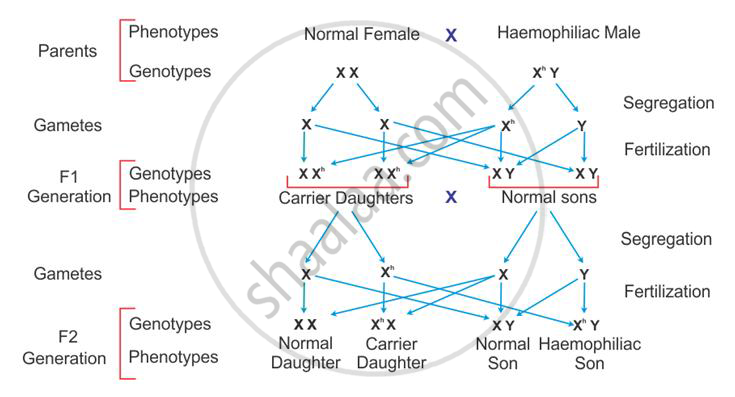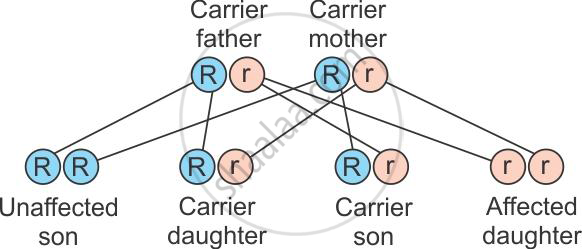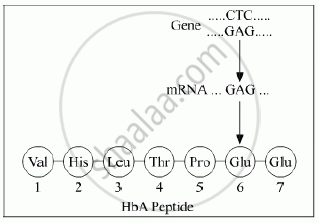Advertisements
Advertisements
Question
(a) Why are thalassemia and haemophilia categorized as Mendelian disorders? Write the symptoms of these diseases. Explain their pattern of inheritance in humans.
(b) Write the genotypes of the normal parents producing a haemophilic son.
Solution
(a) Thalassaemia and haemophilia are categorised as Mendelian disorders because these are determined by alternation or mutation in a single gene.
Symptoms of thalassaemia: The main symptoms of thalassaemia are anaemia, jaundice, hepatosplenomegaly, cardiac enlargement and skeletal deformities.
Symptoms of haemophilia: Haemophilia is also called bleeder’s disease in which a single cut leads to non-stop bleeding. It prevents clotting of blood. A seriously affected person may bleed to death after even a minor skin cut.
Inheritance pattern of haemophilia:
This is a sex-linked recessive disease which shows its transmission from an unaffected carrier female to some of the male progeny. It shows criss-cross inheritance. The heterozygous female (carrier) for haemophilia may transmit the disease to sons. The possibility of a female becoming a haemophilic is extremely rare because the mother of such a female would have to be at least a carrier and the father should be haemophilic.

Inheritance pattern of thalassaemia:
Thalassaemia is an autosomal, recessively inherited blood disorder transmitted to the offspring when both parents are heterozygous. The defect arises because of either mutation or deletion which results in the reduced rate of synthesis of one of the globin chains of haemoglobin.

APPEARS IN
RELATED QUESTIONS
Give any 'two' names of X-linked diseases
Given below is the representation of amino acid composition not the relevant translated portion of β-chain of haemoglobin, related to the shape of human red blood cells

(a) Is this representation indicating a normal human or a sufferer from certain related genetic disease? Give reason in support of your answer.
(b) What difference would be noticed in the phenotype of the normal and the sufferer related to this gene?
(c) Who are likely to suffer more from the defect related to the gene represented the males, the females or both males and females equally? And why?
About 8% of the human male population suffers from colour blindness, whereas only about 0.4% of the human female population suffers from this disease. Write an explanation to show how it is possible.
A male rabbit of genotype 'AABBDDEE' is crossed with a female rabbit of genotype 'aabbddee' to produce F1 hybrid offspring. How many genetically different gametes can be produced by this F1 hybrid?
Match Column I with Column II and select the correct option:
| Column I | Column II | ||
| p. | Pleiotropy | I. | More than two alleles occur at the same locus on homologous chromosomes |
| q. | Multiple alleles | II. | Expression of both the alleles m heterozygous condition |
| r. | Polygenic | III. | Multiple effect of single gene |
| s. | Co-dominance | IV. | Single phenotypic character influenced by more than two genes |
Match the Column-I with Column-II and choose the CORRECT answer
| Column-I | Column-II | ||
| P. | Klinefelter syndrome | i. | Mutation in autosomal gene |
| Q. | Thalassaemia | ii. | Mutation sex chromosome linked gene |
| R. | Down syndrome | iii. | Trisomy of autosome |
| S. | Colour blindness | iv. | Trisomy of sex chromosome |
Conditions of a karyotype 2n ± 1 and 2n ± 2 are called ______.
In sickle-cell anaemia, shape of RBCs under oxygen tension becomes ______.
Failure of segregation of chromatids during cell division results in the gain or loss of chromosomes, this is called as ______.
Read the following and answer from given below:
Turner's syndrome is an example of monosomy. It is formed by the union of an allosome-free egg and a normal 'X' containing sperm or a normal egg and an allosome-free sperm. The individual has 2n = 45 chromosomes (44 + X0) instead of 46. Such individuals are sterile females who have rudimentary ovaries, underdeveloped breasts, small uterus, short stature, webbed neck, and abnormal intelligence. They may not menstruate or ovulate. This disorder can be treated by giving female sex hormones to women from the age of puberty to make them develop breasts and have menstruation. This makes them feel more normal.
Which of the following statements regarding Turner's syndrome is incorrect?
